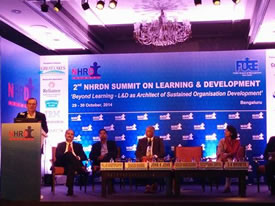 Bangalore, 27 degrees Celsius, hustle and bustle on the busy streets, the sun is shining on an urban soundscape. We, the participants of the conference, notice none of this. Air-conditioning has cooled the windowless conference rooms down to a temperature of sixteen degrees. It is too cold for heated discussions, but there is an atmosphere of critical and constructive grappling with current issues related to »Beyond Learning – L&D as Architect of Sustained Organization Development«. The atmosphere and the conversations are concentrated, interested, open and friendly.
Bangalore, 27 degrees Celsius, hustle and bustle on the busy streets, the sun is shining on an urban soundscape. We, the participants of the conference, notice none of this. Air-conditioning has cooled the windowless conference rooms down to a temperature of sixteen degrees. It is too cold for heated discussions, but there is an atmosphere of critical and constructive grappling with current issues related to »Beyond Learning – L&D as Architect of Sustained Organization Development«. The atmosphere and the conversations are concentrated, interested, open and friendly.
In October, we were invited by the Indian NHRD to participate in the 2nd National Summit on Learning & Development in Bangalore as official knowledge partners. Surrounded by Indian HR staff, psychologists, managers, decision-makers, leadership architects, organizational consultants and students of a business school, we were conspicuous as the only non-Indians in the room. What does it mean to be invited to an Indian conference as a German knowledge partner? What did we experience there and how does that experience impact our work?
The conference was driven by questions of how to deal with VUCA in global conditions and after the sense of human activity and organizational design. The answers contained one assumption: that organizational structures occur through humanness and togetherness in interaction. Hence, the design of relationships is more important than the defence of personal aims when it comes to achieving sustainable action within organizations. In Rüdiger Müngersdorff’s panel »Transformation – Role of L&D – From Solution Provider to Proactive Influencer of Change«, the speakers agreed that it was the proactive behaviour of individuals that made change and variation possible in organizations in the first place and that L&D departments had to be equipped with the according tools and skills in order to enable action. This includes the ability to implement participation concepts as bottom-up architectures: an ability that is currently being lost in a time of top-down, cascading concepts. All participants agreed that vibrancy, agility, alertness, speed can only be developed from within the organisation: middle-bottom up.
We were inspired by insights and statements like the following:
- Participation: VUCA can only be adequately met when all persons in an organization are able to participate. VUCA is not a problem of the subject, but a structural global phenomenon that needs to be addressed from out of the logic of the collective. The performance of an individual only attains its significance in the context of others and has to be motivated by the question of shared values.
- Spirituality: every-day activity derives its meaning from spiritual motivation; shared values are a basic condition for designing organizations. Spirituality is not an end in itself.
- Willingness to change: There is one important prerequisite to learning: unlearning. That includes an awareness of the given conditions and the willingness to undergo a proactive transformation.
What was surprising? The term VUCA and all its levels of interpretation were a key topic. All panels shared the characteristic that they critically addressed conventional L&D strategies: Classic management and senior leadership with all its dominant elements was questioned and participation and organizational development across barriers of function and hierarchy advocated.
To us, every encounter with people, their topics and attitudes always means intercultural and transcultural learning. Such encounters take us away from theoretical analysis and bring us into the midst of direct experience, influencing our notions of the worlds. With our Pashminas still wrapped around us, we return with new strength to the German winter, having gained new stories and enriching perspectives on ourselves and on others.
Hanna Göhler
